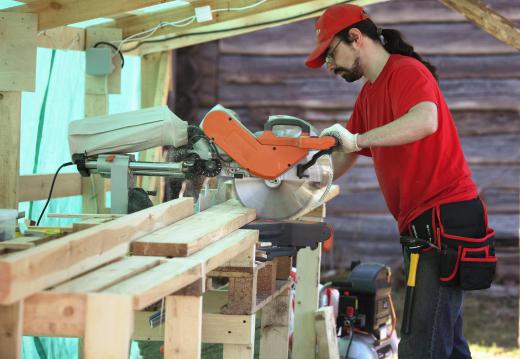Almost every woodworker today uses a table saw. It is one of the most common pieces of equipment in a woodshop. There are two main types of table saws: the cabinet saw and the contractor's saw. One distinction that makes a table saw a cabinet saw is the closed housing that contains it, hence its name. Although that is the most visible difference, many other features set the cabinet saw apart from the contractor saw.
A table saw has a flat surface with a slot opening for a circular saw blade mounted beneath. The table allows stability and accuracy when making cuts. Depending on the depth of cut desired, the saw blade is raised and lowered through the table. Guides on the saw’s tabletop adjust for cuts of variable lengths, widths, or angles. Beneath the table saw’s top, an electric motor, along with gears or belts, drives the saw blade.

Wood is guided towards the saw blade by a rip fence on most table saws. Running parallel to the saw blade, the rip fence is a metal support that provides a level and stable surface for positioning the cut. Most saws also have a miter gauge, which is capable of adjusting for angled cuts as well as crosscuts, which are typically cuts against the grain of the wood. Miter gauge supports run in parallel grooves, but the miter gauge itself is perpendicular.
Unlike the cabinet saw, contractor's saws are intended to be portable and easy to haul between job sites. An open style base makes the saw lighter and generally quicker to set up. The motor is usually easy to access, if needed, for repair or replacement. Additionally, contractor saws tend to be less expensive than cabinet saws.
Sometimes called a cabinetmaker's saw, the cabinet saw is normally a heavy and solid piece of woodworking equipment. The design intent was not for portability, but rather for precision and power. Saw blade mounts and adjustments, also called the trunnion assembly, and the tabletop are independently connected to the frame. With this construction, precise adjustments of the saw blade are possible and help create more accurate cuts. This is one reason that professional cabinet saws are a popular choice for cabinetmakers.
A fully enclosed cabinet base protects the motor and other working parts, as well as allowing for better dust collection. Cabinet saw motors generally have greater horsepower than contractor saws do, which allows them to handle wood at the full cutting depth of the blade. Accessories, such as out-feed supports and tables, attach more easily to the cabinet table saw.
